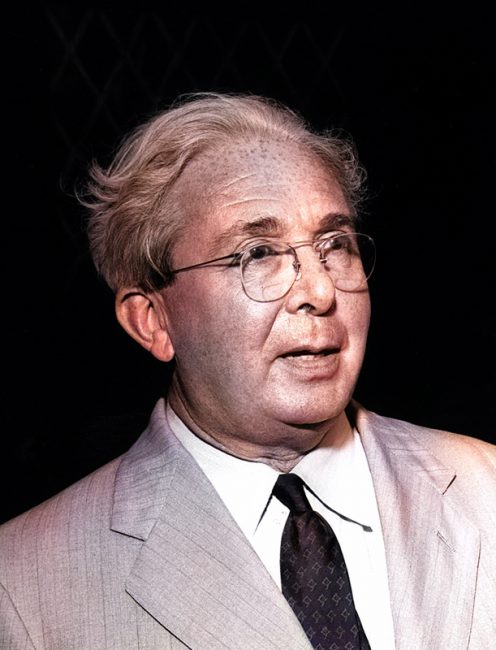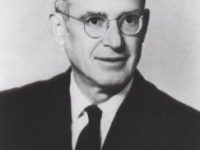
Leó Szilárd (1898–1964)
On February 11, 1898, Hungarian-American physicist and inventor Leo Szilard was born. He conceived the nuclear chain reaction in 1933, patented the idea of a nuclear reactor with Enrico Fermi, and in late 1939 together with Albert Einstein wrote the letter that resulted in the Manhattan Project that built the atomic bomb. He also conceived the electron microscope, the linear accelerator, and also the cyclotron.
“A scientist’s aim in a discussion with his colleagues is not to persuade, but to clarify”
– Leo Szilard, [15]
Leo Szilard Background
Szilárd was born in Budapest, Hungary, as son of Louis Spitz, a Jewish civil engineer, and Thekla Vidor [1]. Already while attending high school, Leo showed an early interest in physics and a proficiency in mathematics. In 1916, he enrolled as an engineering student at Budapest Technical University. The following year he was drafted, but before his regiment was sent to the front lines, Szilárd fell ill with Spanish Influenza and he was returned home for hospitalization. In 1919 he resumed engineering studies at Budapest Technical University but soon decided to leave Hungary due to the chaotic political situation and continued engineering studies at Technische Hochschule (Institute of Technology) in Berlin-Charlottenburg. He soon changed to physics there and took physics classes from Albert Einstein[12] Max Planck, and Max von Laue. With his dissertation on thermodynamics Über die thermodynamischen Schwankungserscheinungen (On The Manifestation of Thermodynamic Fluctuations), praised by Einstein, he was awarded a doctorate in physics from Humboldt University of Berlin in 1922 [4].
Early Career
He was appointed as assistant to Max von Laue at the University of Berlin’s Institute for Theoretical Physics in 1924 , where he finished his habilitation in 1927 to become a Privatdozent (private lecturer) in physics. Throughout his time in Berlin he worked on numerous technical inventions. In 1928 he submitted a patent application for the linear accelerator and, in 1929, he applied for a patent for the cyclotron. Szilárd’s 1929 paper, “Über die Entropieverminderung in einem thermodynamischen System bei Eingriffen intelligenter Wesen” (On the reduction of entropy in a thermodynamic system by the intervention of intelligent beings), introduced the thought experiment now called Szilárd’s engine and became important in the history of attempts to understand Maxwell’s demon. This work also is the first equation of negative entropy and information.
Neutron-Induced Chain Reaction
“The most important step in getting a job done is the recognition of the problem. Once I recognize a problem I usually can think of someone who can work it out better than I could.”
– Leo Szilard, [15]
Szilard went to London in 1933 where he read an article where Ernest Rutherford rejected the feasibility of using atomic energy for practical purposes.[14] Rutherford remarked specifically on the recent 1932 work of his students, John Cockcroft and Ernest Walton, in “splitting” lithium into alpha particles, by bombardment with protons from a particle accelerator they had constructed. Although the atom had been split and energy released, nuclear fission had not yet been discovered. Szilard was reportedly so annoyed at Rutherford’s dismissal that he conceived of the idea of nuclear chain reaction (analogous to a chemical chain reaction), using recently discovered neutrons. The idea did not use the mechanism of nuclear fission, which was not then known, but Leo Szilárd realized that if neutrons could initiate any sort of energy-producing nuclear reaction, such as the one that had occurred in lithium, and could be produced themselves by the same reaction, energy might be obtained with little input, since the reaction would be self-sustaining. The following year he filed for a patent on the concept of the neutron-induced nuclear chain reaction.
In 1938 Szilard accepted an offer to conduct research at Columbia University in Manhattan, and moved to New York. After learning about the successful nuclear fission experiment conducted in 1939 in Germany by Otto Hahn, Fritz Strassmann and Lise Meitner [11], Leo Szilard and Enrico Fermi [10] concluded that uranium would be the element capable of sustaining a chain reaction. Szilárd and Fermi conducted a simple experiment at Columbia and discovered significant neutron multiplication in uranium, proving that the chain reaction was possible and enabling nuclear weapons. At around that time the Germans and others were in a race to produce a nuclear chain reaction. German attempts to control the chain reaction sought to do so using graphite, but these attempts proved unsuccessful. Szilard realized graphite was indeed perfect for controlling chain reactions, and fostered by his attempts, the first human-controlled chain reaction occurred on December 2, 1942.
The Manhattan Project
Szilárd was directly responsible for the creation of the Manhattan Project. In August 1939, together with his old friend Albert Einstein he drafted a confidential letter to Franklin D. Roosevelt explaining the possibility of nuclear weapons, warning of Nazi work on such weapons and encouraging the development of a program which could result in their creation [5]. The Einstein–Szilárd letter resulted in the creation of the Manhattan Project. Leo Szilárd relocated to the University of Chicago to continue work on the project. As the war continued, Szilárd became increasingly dismayed that scientists were losing control of their research to the military. His resentment towards the U.S. government was exacerbated by his failure to prevent the destructive use of the atomic bomb through having a test explosion that could be witnessed by Japanese observers who would then have the opportunity to surrender and spare lives. However, the new U.S. President Harry Truman agreed with advisers and chose to use atomic bombs against Hiroshima and Nagasaki over the protestations of Szilárd and other scientists.
New Endeavors
In 1947, Leo Szilárd switched his field of study from physics to molecular biology. There, he gave essential advice to Theodore Puck and Philip I. Marcus for their first cloning of a human cell in 1955. In February 1950 Leo Szilárd publicly warned of the possibility of a so-called cobalt bomb, a new kind of nuclear weapon using cobalt as a tamper, designed to produce enhanced amounts of radioactive fallout to contaminate a large area with radioactive material. Szilárd suggested that an arsenal of cobalt bombs would be capable of destroying all human life on Earth [6]. In 1961 Szilárd published a book of short stories, The Voice of the Dolphins, in which he dealt with the moral and ethical issues raised by the Cold War and his own role in the development of atomic weapons. In 1960, Szilárd was diagnosed with bladder cancer. He spent his last years as a fellow of the Salk Institute in San Diego until his death in May 1964.
Leo Szilard: The Man Behind the Bomb with William Lanouette, [13]
Acknowledgment:
- We would like to express our heartly thanks to Gene Dannen, who spent decades dedicated to the research of Leo Szilárd’s life. With his support we were able to correct previous errors in this article and provided us with helpful bibliographic references.
References and Further Reading:
- [1] William Lanouette, Genius in the Shadows (Scribners, 1992) p. 21.
- [2] Gene Dannen, The Einstein-Szilard Refrigerators, Scientific American, January 1997.(webpage with further references)
- [3] Leo Szilard online
- [4] Feld and Szilard (eds.) The Collected Works of Leo Szilard: Scientific Papers (MIT Press 1972) pp. 3-15.
- [5] Walter Isaacson, Einstein: His Life and Universe (Simon and Schuster, 2007) pp. 471-475.
- [6] James R. Arnold, The Hydrogen-Cobalt Bomb, Bulletin of the Atomic Scientists, October 1950. Available on Google Books.
- [7] Albert Einstein’s 1939 letter to President Roosevelt
- [8] Leo Szilard biography at biographies.com
- [9] Leo Szilard at Wikidata
- [10] The First Self-Sustained Nuclear Chain Reaction, SciHi Blog, December 2, 2012.
- [11] Lise Meitner – The Misjudged Genius, SciHi Blog, October 27, 2012.
- [12] Albert Einstein revolutionized Physics, SciHi Blog, March 14, 2013.
- [13] Leo Szilard: The Man Behind the Bomb with William Lanouette, University of California Television (UCTV) @ youtube
- [14] Ernest Rutherford Discovers the Nucleus, SciHi Blog
- [15] “Close-up : I’m looking for a market for wisdom. : Leo Szilard, scientist” in LIFE magazine, Vol. 51, no. 9 (1 September 1961), p. 75
- [16] Timeline of Leo Szilard via Wikidata






This blog is based on Wikipedia, and thus repeats Wikipedia’s errors. Wikipedia’s model for crowd-sourcing knowledge is in need of improvement.
Szilard did not come from a religious background, unless being Jewish must mean one is considered religious.
Szilard did not win the Eotvos Prize in mathematics, which is a legendary prize in Hungarian science. The Eotvos Prize for 1916 was won by Albert Kornfeld (Albert Korodi), who later worked with Szilard on the Einstein-Szilard refrigerators.
Szilard received his doctorate in 1922, not 1923.
Szilard and Einstein drafted the letter to Roosevelt together.
Szilard did not ‘propose’ the cobalt bomb. He publicly warned that such a bomb would be possible, if the H-Bomb was created. He was warning of the looming threat of nuclear annihilation.
Other errors also.
Thanks for your elaborate reply!
We know that most of our articles heavily rely on what has been compiled in wikipedia and we also know about it’s deficiencies. In yovisto blog, we are only two people writing all the articles every day for more than 1,000 days now. Thus, we simply are not experts for all the topics and persons mentioned and for more research there simply is no time nor any funds. We really appreciate your suggested corrections. Please provide us with bibliographic references for the mentioned facts to be able to come up with a sound article.
Thanks and best regards,
The yovisto editorial team
Wow. Just two hardworking people!
Easiest to cite my own publications, available on or through my dannen.com website.
I mentioned that Albert Kornfeld (Korodi) won the 1916 Eotvos Prize in my 1997 Scientific American article The Einstein-Szilard Refrigerators. Linked from my website.
The story of the writing of Einstein’s letter to Roosevelt is on my website.
Szilard’s warning about the cobalt bomb can be found in Hawkins, Greb, and Szilard (eds.) Toward a Livable World: Leo Szilard and the Crusade for Nuclear Arms Control (MIT Press 1987) pp. 80-89. Also reprinted in a 1950 issue of Bulletin of the Atomic Scientists, which should be online at Google Books.
Busy now. I’ll add more published references later today.
Thanks a lot! We will rework on our article and include the references. Very much appreciated!
Not from religious background: William Lanouette, Genius in the Shadows (Scribners, 1992) p. 21.
Eotvos Prize won by Albert Kornfeld, not Szilard: Gene Dannen, The Einstein-Szilard Refrigerators, Scientific American, January 1997.
Date of Szilard’s doctorate: Szilard’s curriculum vitae, in Feld and Szilard (eds.) The Collected Works of Leo Szilard: Scientific Papers (MIT Press 1972) pp. 3-15.
Einstein letter to Roosevelt: Walter Isaacson, Einstein: His Life and Universe (Simon and Schuster, 2007) pp. 471-475.
Publicly warned of possibility of cobalt bomb: James R. Arnold, The Hydrogen-Cobalt Bomb, Bulletin of the Atomic Scientists, October 1950. Available on Google Books.
Again, our heartly thanks! We have tried to update the post accordingly, added bibliographic references provided by you… and also added an acknowledgement to thank you for your help!!
Pingback: Whewell’s Gazette: Vol. #35 | Whewell's Ghost
Pingback: Whewell’s Gazette Year 2, Vol. #31 | Whewell's Ghost